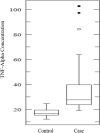Functional impact of allelic variations/haplotypes of TNF-α on reproductive tract infections in Indian women
- PMID: 33436768
- PMCID: PMC7803726
- DOI: 10.1038/s41598-020-79963-y
Functional impact of allelic variations/haplotypes of TNF-α on reproductive tract infections in Indian women
Abstract
The aim of the present study is to investigate the functional role of TNF-α single-nucleotide polymorphisms/haplotypes in an association with reproductive tract infections (RTIs) in symptomatic and asymptomatic women. A total of 850 consecutive subjects consisting of 400 cases and 450 healthy controls, were screened for RTIs, along with their risk factors and associated symptoms. The propensity score matching was performed to reduce the confounding bias arise owing to covariates and to balance the data between two groups. A total of 211 pairs (1:1) have been created. Genotyping of rs1800629 (-308) and rs361525 (-238) SNPs of TNF-α was done by PCR-RFLP followed by sequencing. The functional implication of TNF-α SNPs in an association with RTIs was also checked by using ELISA. The frequency of -238A allele and -308A allele was found to be twofold (P < 0.0001) and threefold (P < 0.0001) higher in the presence of RTIs. AA haplotype emerged as a major player in an association with RTIs and elevated TNF-α expression. The present study revealed the functional role of rs1800629 (-308) and rs361525 (-238) of TNF-α in an association with RTIs. This information may be used to establish biomarkers for an inflammatory response during the persistence of RTIs.
Conflict of interest statement
The authors declare no competing interests.
Figures




Similar articles
-
Association of TNF-α gene alterations (c.-238G>A, c.-308G>A, c.-857C>T, c.-863C>A) with primary glaucoma in north Indian cohort.Gene. 2019 Aug 15;709:25-35. doi: 10.1016/j.gene.2019.05.035. Epub 2019 May 25. Gene. 2019. PMID: 31132515
-
Promoter variants of TNF-α rs1800629 and IL-10 rs1800871 are independently associated with the susceptibility of coronary artery disease in north Indian.Cytokine. 2018 Oct;110:131-136. doi: 10.1016/j.cyto.2018.04.035. Epub 2018 May 4. Cytokine. 2018. PMID: 29734056
-
Association Analysis of Tumor Necrosis Factor Alpha Promoter Polymorphisms and Vitiligo Susceptibility in South Indian Tamils.Dermatology. 2020;236(6):554-564. doi: 10.1159/000505544. Epub 2020 Feb 19. Dermatology. 2020. PMID: 32074604
-
Association of TNF polymorphisms with sarcoidosis, its prognosis and tumour necrosis factor (TNF)-alpha levels in Asian Indians.Clin Exp Immunol. 2008 Feb;151(2):251-9. doi: 10.1111/j.1365-2249.2007.03564.x. Epub 2007 Dec 6. Clin Exp Immunol. 2008. PMID: 18062795 Free PMC article. Review.
-
Tumor necrosis factor gene polymorphisms are associated with silicosis: a systemic review and meta-analysis.Biosci Rep. 2019 Feb 5;39(2):BSR20181896. doi: 10.1042/BSR20181896. Print 2019 Feb 28. Biosci Rep. 2019. PMID: 30643011 Free PMC article.
Cited by
-
Current Progress and Future Perspective of Chlamydia trachomatis Infection: A Rising Threat to Women Health.Curr Microbiol. 2025 May 29;82(7):314. doi: 10.1007/s00284-025-04287-x. Curr Microbiol. 2025. PMID: 40442335 Review.
-
The effect of calcium oxalate stones and uric acid stones on male sexual function.Int Urol Nephrol. 2025 Jan;57(1):19-25. doi: 10.1007/s11255-024-04127-0. Epub 2024 Jul 3. Int Urol Nephrol. 2025. PMID: 38958853
-
Improved management can be achieved by introducing additional parameters in the syndromic diagnosis of nonviral sexually transmitted infections at low-resource settings.AJOG Glob Rep. 2021 Dec 4;2(1):100037. doi: 10.1016/j.xagr.2021.100037. eCollection 2022 Feb. AJOG Glob Rep. 2021. PMID: 36274971 Free PMC article.
-
Multiple sexually transmitted co-infections are associated with adverse reproductive outcomes in asymptomatic adolescent pregnant women; A Prospective cohort study.Front Med (Lausanne). 2022 Nov 17;9:1046233. doi: 10.3389/fmed.2022.1046233. eCollection 2022. Front Med (Lausanne). 2022. PMID: 36465932 Free PMC article.
-
Alkhumra Hemorrhagic Fever Virus (AHFV): A Concise Overview.Yale J Biol Med. 2024 Dec 19;97(4):505-514. doi: 10.59249/QSPC8835. eCollection 2024 Dec. Yale J Biol Med. 2024. PMID: 39703604 Free PMC article. Review.
References
-
- WHO. World Health Organization. Prevalance and Incidence of Selected Sexually Transmitted Infections. 2011.
Publication types
MeSH terms
Substances
LinkOut - more resources
Full Text Sources
Other Literature Sources

